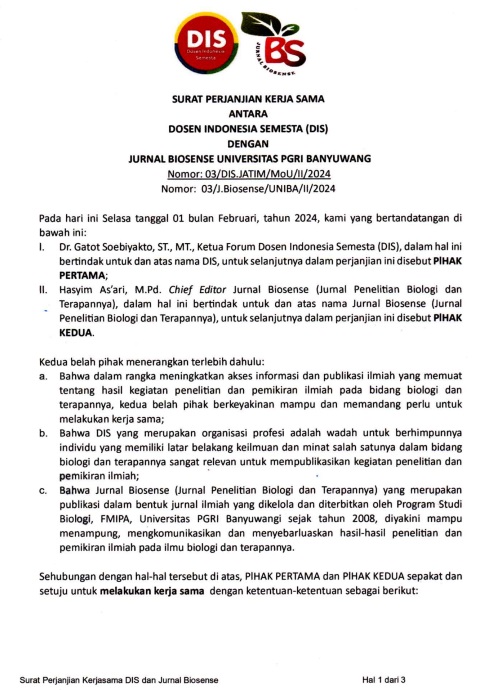ANALISIS KANDUNGAN KALIUM PADA AIR IRIGASI DI DAERAH IRIGASI GLUNDENGAN KECAMATAN WULUHAN KABUPATEN JEMBER
DOI:
https://doi.org/10.36526/biosense.v5i2.2241Keywords:
Irrigation Water, Water Quality Standards, PotassiumAbstract
Utilization of water for agricultural purposes is the highest, reaching 70% of the total utilization of water resources globally. In the Glundengan Irrigation Area, Wuluhan District, Jember Regency, with an area of 4996 ha, irrigation water is taken from the Bedadung River, and the excess water is discharged from the Glundengan Irrigation Area to the Bedadung River. This encourages research on the quality of irrigation water in these irrigation areas. This study aims to analyze the quality of irrigation water, especially the elemental content of potassium in the Glundengan irrigation channel. In the analysis of the quality of irrigation water, temporary sampling was carried out at two points, namely in the primary channel which carries water to the paddy fields and in the drainage channel which removes excess water from the irrigation area. The temperature and pH parameter analysis method used the standard SNI 6989.57:2008, while the K parameter analysis was carried out in the CDAST laboratory using the Flame Photometry-AAS method. The results of the analysis are compared with the water quality standards in Government Regulation No. 82 of 2001 (PP 82/2001): Management of Water Quality and Control of Water Pollution. The results of the analysis show that the temperature parameters in the primary and exhaust channels are 24°C respectively. The pH parameters in the primary and sewer channels were 7.5 and 7.2, respectively. The K parameters in the primary and sewer channels were 0.00593 mg/l and 0.00745 mg/l respectively, these figures were relatively small. These three parameters meet the water quality standards of Class II according to PP 82/2001.
References
Mustika, A dan A. Sofyan. 2016. "Kajian Beban Pencemaran di Sungai Citarum Menggunakan Pemodelan Qual2K." Jurnal Teknik Lingkungan 22 (2): 1-12. https://journals.itb.ac.id/index.php/jtl/article/view/11956.
Oktavia, I., Junaidi, dan G. Samudro. 2014. "Pengaruh Ph Dan Nutrisi Kalium Terhadap Penyisihan Parameter Total N Dan Total P Pada Remediasi Air Rawa Pening Menggunakan Mikroalga." Jurnal Teknik Lingkungan 3 (2): 1-13.
Purnadi, Y.S. 2014. Persepsi Petani Mengenai Pengaruh Kualitas Air Irigasi Terhadap Produktivitas Padi. Salatiga: Fakultas Pertanian UKSW.
Ratnawati, Rhenny, Indah Nurhayati, and Venny Y. Sari. 2020. "Pengaruh Konsentrasi Unsur Kalium, Karbon, dan Aerasi pada Bioremediasi Air Limbah Boezem dengan High Rate Algae Pond." Teknik 41 (2): 119-124. Accessed November 10, 2022. doi:https://doi.org/10.14710/teknik.v0i0.24518.
Sakti, A.D., L. Fajri dan K. Wikantika. 2019. "Pemodelan Redistribusi Penggunaan Air Pertanian Global Untuk Meminimalisir Krisis Air Masa Depan Menggunakan Integrasi Data Penginderaan Jauh dan Model KoefisienTanam." Seminar Nasional Penginderaan Jauh ke-6.
Smith, C.J, J.D. Oster and G.Sposito. 2015. "Potassium and magnesium in irrigation water quality assessment." Elsevier. doi:https://doi.org/10.1016/j.agwat.2014.09.003.
Yusuf, I.A. 2014. "Kajian Kriteria Mutu Air Irigasi." Jurnal Irigasi 9 (1).

















